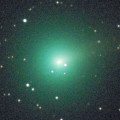
|
Now it is 8.2 mag (Jan. 21, Michael Jager). It will fade out rapidly after this. It stays observable in good condition.
Date(TT) R.A. (2000) Decl. Delta r Elong. m1 Best Time(A, h)
Jan. 20 12 18.08 10 40.0 0.503 1.302 118 7.4 4:24 ( 0, 66)
Jan. 27 12 29.09 10 10.0 0.501 1.324 122 7.7 4:07 ( 0, 65)
|

|
Now it is 10.2 mag (Jan. 19, Osamu Miyazaki). It will fade out rapidly after this. It stays observable in good condition. It is fainter than this ephemeris recently.
Date(TT) R.A. (2000) Decl. Delta r Elong. m1 Best Time(A, h)
Jan. 20 3 39.78 14 53.5 0.645 1.400 116 9.1 19:44 ( 0, 70)
Jan. 27 3 56.37 15 19.8 0.672 1.399 113 8.7 19:33 ( 0, 70)
|

|
It returns for the first time in 70 years. It will brighten up to 4.5 mag in spring. It suddenly brightened in major outburst by 5 mag up to 11.5 mag on July 20 (E. Tamas, Francois Kugel). It brightened again in another major outburst up to 9.4 mag on Nov. 15 (Nick James). Now it is 8.0 mag (Jan. 21, Michael Jager). It will brighten rapidly after this. In the Northern Hemisphere, it will be unobservable in April. In the Southern Hemisphere, it is not observable now, but it will appear in April.
Date(TT) R.A. (2000) Decl. Delta r Elong. m1 Best Time(A, h)
Jan. 20 20 36.55 38 5.3 2.044 1.752 58 8.8 18:43 (123, 20)
Jan. 27 21 2.51 38 13.5 1.969 1.659 57 8.9 18:50 (124, 19)
|
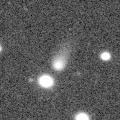
|
Now it is 10.3 mag (Jan. 21, Chris Wyatt). It stays 10 mag for a while. In the Northern Hemisphere, it will be getting higher gradually. In the Southern Hemisphere, it stays observable in good condition.
Date(TT) R.A. (2000) Decl. Delta r Elong. m1 Best Time(A, h)
Jan. 20 15 58.66 -32 3.8 1.663 1.375 55 9.6 5:37 (328, 14)
Jan. 27 16 23.00 -28 58.1 1.588 1.349 57 9.5 5:35 (327, 17)
|
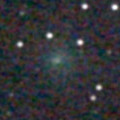
|
Now it is 13.3 mag (Dec. 16, Michael Mattiazzo). It will fade out rapidly after this. It will be fainter than 18 mag in April. Now it is not observable. It will appear in February in the Southern Hemisphere, or in March in the Northern Hemisphere.
Date(TT) R.A. (2000) Decl. Delta r Elong. m1 Best Time(A, h)
Jan. 20 20 39.47 -36 36.0 1.709 0.830 17 11.2 18:43 ( 59,-20)
Jan. 27 20 28.69 -35 51.2 1.730 0.841 17 11.4 5:35 (297,-25)
|

|
It approached to Earth down to 0.38 a.u., and brightened up to 8.0 mag in autumn (Sept. 29, Virgilio Gonano). Now it is 13.5 mag (Jan. 15, Toshihiko Ikemura, Hirohisa Sato). It will fade out rapidly after this. It stays observable in good condition.
Date(TT) R.A. (2000) Decl. Delta r Elong. m1 Best Time(A, h)
Jan. 20 8 24.06 -12 46.4 0.756 1.668 146 12.4 0:31 ( 0, 42)
Jan. 27 8 15.99 -11 20.6 0.807 1.730 149 12.8 23:50 ( 0, 44)
|
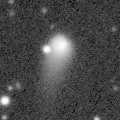
|
Now it is 12.2 mag (Jan. 21, Osamu Miyazaki). It stays 13 mag for a while. In the Northern Hemisphere, it stays observable in good condition.
Date(TT) R.A. (2000) Decl. Delta r Elong. m1 Best Time(A, h)
Jan. 20 8 42.02 17 11.9 3.258 4.231 170 12.6 0:49 ( 0, 72)
Jan. 27 8 30.17 18 53.2 3.217 4.201 179 12.5 0:10 ( 0, 74)
|

|
It was observed at 9-10 mag for a long time in 2023. Now it is 13.0 mag (Jan. 3, Chris Wyatt). Fading slowly. In the Northern Hemisphere, it will be unobservable soon. It locates somewhat low in the Southern Hemisphere. But it will become high in spring.
Date(TT) R.A. (2000) Decl. Delta r Elong. m1 Best Time(A, h)
Jan. 20 23 22.02 -40 20.5 4.193 3.584 46 12.7 18:43 ( 35, 2)
Jan. 27 23 25.04 -40 3.0 4.306 3.639 42 12.8 18:50 ( 40, -1)
|

|
Now it is 12.7 mag (Jan. 9, Yukihiro Sugiyama). It will fade out rapidly after this. It will be fainter than 18 mag in March. It stays extremely low.
Date(TT) R.A. (2000) Decl. Delta r Elong. m1 Best Time(A, h)
Jan. 20 17 48.73 -16 39.0 1.835 1.135 32 12.9 5:37 (299, 10)
Jan. 27 18 16.05 -15 7.1 1.857 1.165 33 13.4 5:35 (297, 11)
|

|
It brightened up to 8 mag from 2022 summer to 2023 spring. Now it is 13.0 mag (Jan. 21, Chris Wyatt). Fading slowly. In the Northern Hemisphere, it will be getting lower gradually after this, and it will be unobservable in May. In the Southern Hemisphere, it stays observable in good condition.
Date(TT) R.A. (2000) Decl. Delta r Elong. m1 Best Time(A, h)
Jan. 20 5 20.92 -0 8.3 4.035 4.781 134 13.0 21:24 ( 0, 55)
Jan. 27 5 16.36 0 56.2 4.170 4.843 128 13.1 20:52 ( 0, 56)
|
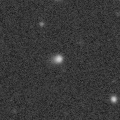
|
It will approach to Sun down to 0.4 a.u. in late September, and it is expected to brighten up to 0 mag. Now it is 13.5 mag (Jan. 21, Michael Jager). It will brighten rapidly after this. It stays observable in good condition. At the high light, in the Northern Hemisphere, it will be observable in good condition after the perihelion passage. In the Southern Hemisphere, it will be observable in the low sky before and after the perihelion passage.
Date(TT) R.A. (2000) Decl. Delta r Elong. m1 Best Time(A, h)
Jan. 20 15 8.16 -7 47.4 4.218 4.033 72 13.7 5:37 (327, 41)
Jan. 27 15 9.80 -7 52.4 4.017 3.952 79 13.5 5:35 (335, 44)
|

|
Now it is 12.5 mag (Jan. 21, Chris Wyatt). It stays observable in good condition.
Date(TT) R.A. (2000) Decl. Delta r Elong. m1 Best Time(A, h)
Jan. 20 8 26.28 21 4.7 5.191 6.171 174 13.5 0:33 ( 0, 76)
Jan. 27 8 22.75 21 11.4 5.190 6.173 176 13.5 0:02 ( 0, 76)
|

|
Now it is 13.7 mag (Jan. 21, Chris Wyatt). Fading slowly. In the Northern Hemisphere, it will be unobservable in May. In the Southern Hemisphere, it stays observable in good condition.
Date(TT) R.A. (2000) Decl. Delta r Elong. m1 Best Time(A, h)
Jan. 20 9 31.57 -44 56.7 4.016 4.475 111 13.6 1:38 ( 0, 10)
Jan. 27 9 17.30 -45 32.5 4.005 4.510 114 13.6 0:57 ( 0, 9)
|

|
Now it is 14.2 mag (Jan. 16, Ken-ichi Kadota). Brightening slowly. It locates somewhat low in the Northern Hemisphere. In the Southern Hemisphere, it stays observable in good condition. It is expected to brighten up to 12.5 mag in spring. At the high light, it will be observable in excellent condition in the Southern Hemisphere, but it will be low in the Northern Hemisphere.
Date(TT) R.A. (2000) Decl. Delta r Elong. m1 Best Time(A, h)
Jan. 20 15 30.61 -21 38.3 3.042 2.748 63 13.7 5:37 (329, 27)
Jan. 27 15 28.30 -23 13.6 2.896 2.734 70 13.6 5:35 (336, 28)
|
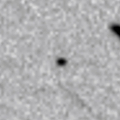
|
It will approach to Earth down to 0.2 a.u. from February to March, and it is expected to brighten up to 13 mag. Now it is 14.7 mag (Jan. 16, Hiroshi Abe). It will turn to fade out rapidly after brightening. It will be fainter than 18 mag in May. It stays observable in good condition.
Date(TT) R.A. (2000) Decl. Delta r Elong. m1 Best Time(A, h)
Jan. 20 1 14.36 -15 25.5 0.449 0.956 73 14.1 18:43 ( 25, 36)
Jan. 27 1 37.73 -15 57.6 0.405 0.941 71 13.8 18:50 ( 28, 34)
|
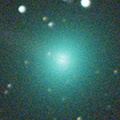
|
It approached to Earth down to 0.2 a.u. in early November, and brightened up to 6.2 mag (Nov. 11, Marco Goiato). Now it is 13.2 mag (Jan. 3, Chris Wyatt). Fading rapidly. In the Northern Hemisphere, it will be unobservable soon. It locates somewhat low in the Southern Hemisphere.
Date(TT) R.A. (2000) Decl. Delta r Elong. m1 Best Time(A, h)
Jan. 20 23 32.84 -43 2.4 2.134 1.659 48 14.1 18:43 ( 32, 1)
Jan. 27 23 41.57 -43 11.3 2.279 1.749 46 14.5 18:50 ( 36, -2)
|

|
It brightened up to 7.8 mag in late July (July 20, Thomas Lehmann). Now it is 14.4 mag (Jan. 14, Giuseppe Pappa). Fading slowly. In the Northern Hemisphere, it stays observable in good condition. In the Southern Hemisphere, it will be getting higher gradually.
Date(TT) R.A. (2000) Decl. Delta r Elong. m1 Best Time(A, h)
Jan. 20 15 11.69 -2 21.0 2.821 2.712 73 14.1 5:37 (323, 46)
Jan. 27 15 7.88 -0 53.6 2.746 2.781 81 14.1 5:35 (331, 50)
|

|
Now it is 14.0 mag (Jan. 18, Chris Wyatt). It stays 14 mag for a while. It stays extremely low in the Northern Hemisphere. In the Southern Hemisphere, it stays observable in good condition.
Date(TT) R.A. (2000) Decl. Delta r Elong. m1 Best Time(A, h)
Jan. 20 12 13.53 -38 16.5 5.077 5.294 97 14.3 4:19 ( 0, 17)
Jan. 27 12 14.53 -38 34.5 4.967 5.276 102 14.2 3:53 ( 0, 16)
|

|
It brightened up to 8.3 mag in 2021-2022 winter (Jan. 6, 2022, Toshiyuki Takahashi). Now it is 15.0 mag (Jan. 11, ATLAS Chile). It stays 15 mag for a while. It stays extremely low in the Northern Hemisphere. In the Southern Hemisphere, it stays observable in good condition.
Date(TT) R.A. (2000) Decl. Delta r Elong. m1 Best Time(A, h)
Jan. 20 11 25.55 -51 43.9 6.987 7.152 95 14.3 3:32 ( 0, 3)
Jan. 27 11 23.19 -52 23.1 6.960 7.197 100 14.3 3:02 ( 0, 3)
|

|
First return of a new periodic comet which brightened up to 10 mag in 2001. It is expected to brighten up to 12-13 mag from February to March. Now it is 16.4 mag (Jan. 11, Toshihiko Ikemura, Hirohisa Sato). Brightening gradually. In the Northern Hemisphere, it will be getting lower gradually. But it will be getting higher again after April. In the Southern Hemisphere, it will be unobservable soon. Thomas Lehmann reported it was bright as 13.7 mag on Jan. 9.
Date(TT) R.A. (2000) Decl. Delta r Elong. m1 Best Time(A, h)
Jan. 20 23 28.35 7 29.5 1.769 1.488 57 15.2 18:43 ( 70, 39)
Jan. 27 23 35.53 11 32.3 1.804 1.461 53 14.4 18:50 ( 79, 36)
|
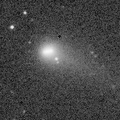
|
Now it is 14.0 mag (Jan. 16, Hiroshi Abe). It stays 15 mag for a while. In the Northern Hemisphere, it stays observable in good condition. It locates somewhat low in the Southern Hemisphere.
Date(TT) R.A. (2000) Decl. Delta r Elong. m1 Best Time(A, h)
Jan. 20 2 50.44 20 23.8 1.675 2.179 107 14.7 18:54 ( 0, 76)
Jan. 27 2 56.34 21 11.9 1.731 2.157 101 14.7 18:50 ( 16, 76)
|

|
It returned for the first time in 68 years. It will brighten up to 7.5 mag in summer. Now it is 15.0 mag (Jan. 16, Hidenori Nohara). It will brighten rapidly after this. In the Northern Hemisphere, it stays observable in good condition. In the Southern Hemisphere, it will be getting lower gradually after this, and it will be unobservable in May. At the high light, it locates low in the Northern Hemisphere, or it is not observable in the Southern Hemisphere.
Date(TT) R.A. (2000) Decl. Delta r Elong. m1 Best Time(A, h)
Jan. 20 2 52.98 -9 50.1 2.194 2.521 97 15.0 18:56 ( 0, 45)
Jan. 27 2 51.81 -7 35.3 2.211 2.447 91 14.8 18:50 ( 8, 47)
|
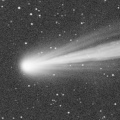
|
It approached to Sun down to 0.23 a.u. and brightened up to 2.5 mag in mid September (Sept. 18, Juan Jose Gonzalez). Now it is 16.2 mag (Jan. 7, Martin Masek). It will fade out rapidly after this. It will be fainter than 18 mag in May. In the Northern Hemisphere, it is not observable now, but it will appear in February. In the Southern Hemisphere, it stays observable in good condition.
Date(TT) R.A. (2000) Decl. Delta r Elong. m1 Best Time(A, h)
Jan. 20 11 13.02 -56 53.3 2.266 2.522 93 14.8 3:20 ( 0, -2)
Jan. 27 10 47.37 -57 28.8 2.282 2.622 98 15.0 2:27 ( 0, -3)
|

|
It brightened up to 12.1 mag in 2023 spring (May 20, Jose Guilherme de S. Aguiar). Now it is 14.8 mag (Jan. 21, Chris Wyatt). Fading slowly. In the Northern Hemisphere, it is not observable now. In the Southern Hemisphere, it stays observable in good condition.
Date(TT) R.A. (2000) Decl. Delta r Elong. m1 Best Time(A, h)
Jan. 20 3 45.84 -77 3.9 4.060 3.932 75 14.9 19:47 ( 0,-22)
Jan. 27 3 45.58 -74 36.6 4.084 3.972 76 15.0 19:20 ( 0,-19)
|
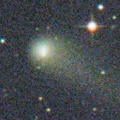
|
It brightened up to 11.1 mag in early 2022 (Mar. 31, 2022, F. Kugel, J.-G. Bosch, J. Nicolas). Now it is 15.4 mag (Jan. 18, ATLAS-MLO, Mauna Loa). It stays 16 mag for a while. In the Northern Hemisphere, it stays observable in good condition. In the Southern Hemisphere, it is not observable now, but it will appear in February.
Date(TT) R.A. (2000) Decl. Delta r Elong. m1 Best Time(A, h)
Jan. 20 17 16.04 18 9.8 6.830 6.340 56 15.4 5:37 (274, 38)
Jan. 27 17 20.93 18 46.3 6.807 6.379 60 15.4 5:35 (276, 42)
|

|
Now it is 15.4 mag (Jan. 15, Toshihiko Ikemura, Hirohisa Sato). It will fade out rapidly after this. It will be fainter than 18 mag in April. In the Northern Hemisphere, it stays observable in good condition. In the Southern Hemisphere, it will be unobservable in March.
Date(TT) R.A. (2000) Decl. Delta r Elong. m1 Best Time(A, h)
Jan. 20 1 8.42 2 0.4 1.721 1.788 77 15.7 18:43 ( 38, 51)
Jan. 27 1 17.03 5 44.6 1.804 1.797 73 15.8 18:50 ( 49, 51)
|

|
Now it is 15.6 mag (Jan. 11, Toshihiko Ikemura, Hirohisa Sato). It stays 16 mag for a while. In the Northern Hemisphere, it will be getting lower gradually after this, and it will be unobservable in May. In the Southern Hemisphere, it stays observable in good condition.
Date(TT) R.A. (2000) Decl. Delta r Elong. m1 Best Time(A, h)
Jan. 20 4 29.94 -10 19.2 6.444 6.973 118 15.9 20:33 ( 0, 45)
Jan. 27 4 29.00 -9 42.8 6.497 6.943 113 15.8 20:05 ( 0, 45)
|
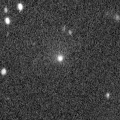
|
Very large comet. It is expected to brighten up to 13 mag in 2031. Now it is 15.9 mag (Jan. 1, Thomas Lehmann). It stays 16 mag for a while. In the Northern Hemisphere, it is not observable now. In the Southern Hemisphere, it stays observable in good condition. In the Northern Hemisphere, it is not observable until 2030.
Date(TT) R.A. (2000) Decl. Delta r Elong. m1 Best Time(A, h)
Jan. 20 2 52.13 -64 43.3 16.984 16.783 76 15.9 18:55 ( 0,-10)
Jan. 27 2 51.88 -64 25.3 16.985 16.758 75 15.9 18:50 ( 2, -9)
|
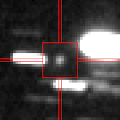
|
It is expected to brighten up to 12.5 mag in summer. Now it is 17.1 mag (Dec. 20, E. Cortes). Brightening gradually. In the Northern Hemisphere, it is not observable now. In the Southern Hemisphere, it stays observable in good condition. Around the high light, it is observable in good condition in the Southern Hemisphere, but it locates very low in the Northern Hemisphere.
Date(TT) R.A. (2000) Decl. Delta r Elong. m1 Best Time(A, h)
Jan. 20 14 49.44 -62 27.7 4.249 3.968 66 16.1 5:37 (351, -9)
Jan. 27 15 2.21 -63 43.0 4.136 3.914 70 16.0 5:35 (353,-10)
|

|
It brightened up to 14 mag in early 2023 and 2023 autumn. Now it is 16.4 mag (Jan. 15, Toshihiko Ikemura, Hirohisa Sato). It stays 16 mag for a while. In the Northern Hemisphere, it will be unobservable in February. But it will be observable again in March. In the Southern Hemisphere, it is not observable now, but it will appear in April.
Date(TT) R.A. (2000) Decl. Delta r Elong. m1 Best Time(A, h)
Jan. 20 22 31.36 4 51.4 4.580 3.930 43 16.0 18:43 ( 77, 26)
Jan. 27 22 32.54 5 21.3 4.699 3.967 37 16.1 18:50 ( 83, 19)
|

|
Now it is 16.7 mag (Jan. 12, ATLAS Chile). It stays 16 mag for a while. In the Northern Hemisphere, it will be unobservable in March. In the Southern Hemisphere, it will be getting lower gradually. But it will be getting higher again after May. The brightness evolution is slower than originally expected.
Date(TT) R.A. (2000) Decl. Delta r Elong. m1 Best Time(A, h)
Jan. 20 1 40.21 -30 32.4 3.438 3.317 74 16.1 18:43 ( 14, 23)
Jan. 27 1 40.18 -30 37.4 3.496 3.279 69 16.1 18:50 ( 21, 21)
|

|
Now it is 16.0 mag (Jan. 5, Ken-ichi Kadota). Fading gradually. It will be fainter than 18 mag in April. In the Northern Hemisphere, it will be getting lower gradually. In the Southern Hemisphere, it will be unobservable in March.
Date(TT) R.A. (2000) Decl. Delta r Elong. m1 Best Time(A, h)
Jan. 20 0 14.36 6 8.1 2.331 2.143 66 16.3 18:43 ( 58, 46)
Jan. 27 0 28.07 7 24.5 2.408 2.152 63 16.4 18:50 ( 64, 43)
|
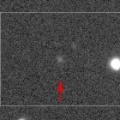
|
It will be observable at 15-16 mag from 2024 to 2025. Now it is 17.6 mag (Jan. 14, Jean-Claude Merlin). It stays 16 mag for a while. It stays observable in good condition.
Date(TT) R.A. (2000) Decl. Delta r Elong. m1 Best Time(A, h)
Jan. 20 13 15.01 1 33.6 3.388 3.723 102 16.4 5:21 ( 0, 56)
Jan. 27 13 17.27 1 31.9 3.272 3.707 108 16.3 4:56 ( 0, 56)
|

|
It brightened up to 13 mag in early 2023. It stays 17 mag for a while. In the Northern Hemisphere, it is not observable now, but it will be observable soon. In the Southern Hemisphere, it stays observable in good condition.
Date(TT) R.A. (2000) Decl. Delta r Elong. m1 Best Time(A, h)
Jan. 20 16 14.77 -48 13.4 4.109 3.612 53 16.4 5:37 (334, -1)
Jan. 27 16 21.09 -48 9.4 4.089 3.671 58 16.4 5:35 (337, 1)
|
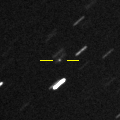
|
Now it is 16.4 mag (Jan. 15, ATLAS-HKO, Haleakala). Fading slowly. It stays observable in good condition.
Date(TT) R.A. (2000) Decl. Delta r Elong. m1 Best Time(A, h)
Jan. 20 9 6.61 -7 56.7 0.911 1.821 147 16.5 1:13 ( 0, 47)
Jan. 27 9 1.69 -10 9.3 0.881 1.804 150 16.4 0:41 ( 0, 45)
|
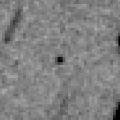
|
Now it is 15.8 mag (Jan. 14, Toshihiko Ikemura, Hirohisa Sato). Fading slowly. It will be fainter than 18 mag in May. In the Northern Hemisphere, it stays observable in good condition. It locates somewhat low in the Southern Hemisphere.
Date(TT) R.A. (2000) Decl. Delta r Elong. m1 Best Time(A, h)
Jan. 20 7 31.39 39 9.2 0.732 1.690 159 16.6 23:34 (180, 86)
Jan. 27 7 27.67 39 23.4 0.729 1.673 154 16.5 23:03 (180, 86)
|

|
It is expected to brighten up to 13 mag in early summer. Now it is 16.1 mag (Jan. 15, Ken-ichi Kadota). It will brighten rapidly after this. It locates somewhat low in the Northern Hemisphere. In the Southern Hemisphere, it will be getting lower gradually after this, and it will be unobservable in April. At the high light, it is not observable in the Southern Hemisphere, or it locates low in the Northern Hemisphere.
Date(TT) R.A. (2000) Decl. Delta r Elong. m1 Best Time(A, h)
Jan. 20 2 2.12 -27 14.9 2.205 2.258 80 16.8 18:43 ( 10, 27)
Jan. 27 2 1.15 -23 38.0 2.208 2.177 75 16.6 18:50 ( 19, 29)
|

|
First return of a new periodic comet which was discovered in 2011, half a year after the perihelion passage. It is expected to brighten up to 14.5 mag in spring. Maik Meyer pointed out the identification of Asteroid 2023 WM26 and this comet. Now it is 16.3 mag (Jan. 14, ATLAS-MLO, Mauna Loa). Brightening gradually. It stays observable in good condition.
Date(TT) R.A. (2000) Decl. Delta r Elong. m1 Best Time(A, h)
Jan. 20 8 36.18 14 13.5 0.883 1.860 170 16.9 0:43 ( 0, 69)
Jan. 27 8 27.48 12 44.0 0.818 1.799 173 16.6 0:07 ( 0, 68)
|
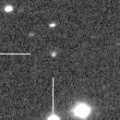
|
Now it is 16.5 mag (Jan. 9, Toshihiko Ikemura, Hirohisa Sato). It stays 16 mag for a while. It locates somewhat low in the Northern Hemisphere. But it will become high in summer. In the Southern Hemisphere, it stays observable in good condition.
Date(TT) R.A. (2000) Decl. Delta r Elong. m1 Best Time(A, h)
Jan. 20 13 45.70 -27 5.1 3.400 3.455 84 16.7 5:37 (356, 28)
Jan. 27 13 52.12 -27 36.4 3.302 3.450 90 16.7 5:30 ( 0, 27)
|
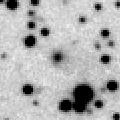
|
Now it is 16.7 mag (Jan. 8, ATLAS-MLO, Mauna Loa). It stays 17 mag for a while. In the Northern Hemisphere, it stays observable in good condition. In the Southern Hemisphere, it will be unobservable in April.
Date(TT) R.A. (2000) Decl. Delta r Elong. m1 Best Time(A, h)
Jan. 20 4 32.28 40 54.8 6.007 6.690 130 16.7 20:36 (180, 84)
Jan. 27 4 31.73 40 41.2 6.089 6.691 124 16.8 20:08 (180, 84)
|

|
Now it is 17.0 mag (Jan. 9, Toshihiko Ikemura, Hirohisa Sato). It stays 17 mag for a while. In the Northern Hemisphere, it stays observable in good condition. It locates somewhat low in the Southern Hemisphere. But it will become high in autumn.
Date(TT) R.A. (2000) Decl. Delta r Elong. m1 Best Time(A, h)
Jan. 20 4 34.59 31 49.8 4.340 5.050 131 16.7 20:38 ( 0, 87)
Jan. 27 4 34.04 31 6.1 4.408 5.035 124 16.8 20:10 ( 0, 86)
|
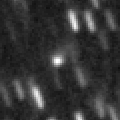
|
It stays 16 mag in the Southern sky for a long time from 2024 to 2025. It stays 16 mag for a while. In the Northern Hemisphere, it is not observable now, but it will be observable soon. In the Southern Hemisphere, it will be getting higher gradually.
Date(TT) R.A. (2000) Decl. Delta r Elong. m1 Best Time(A, h)
Jan. 20 16 53.51 -43 27.2 6.559 5.917 45 16.8 5:37 (326, -1)
Jan. 27 16 54.70 -44 1.3 6.446 5.892 52 16.7 5:35 (330, 1)
|
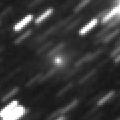
|
Very far object. Now it is 16.8 mag (Jan. 7, ATLAS Chile). It stays 17 mag for a while. In the Northern Hemisphere, it is not observable now. In the Southern Hemisphere, it stays observable in good condition.
Date(TT) R.A. (2000) Decl. Delta r Elong. m1 Best Time(A, h)
Jan. 20 2 19.00 -72 36.2 10.586 10.319 71 16.8 18:43 ( 2,-18)
Jan. 27 2 15.55 -71 45.7 10.602 10.320 70 16.8 18:50 ( 5,-17)
|
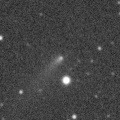
|
It brightened very rapidly up to 14.9 mag in early summer (July 13, Taras Prystavski). Now it is 17.2 mag (Jan. 16, Ken-ichi Kadota). Fading gradually. It will be fainter than 18 mag in April. In the Northern Hemisphere, it stays observable in good condition.
Date(TT) R.A. (2000) Decl. Delta r Elong. m1 Best Time(A, h)
Jan. 20 15 3.88 4 6.2 2.603 2.579 77 17.0 5:37 (320, 52)
Jan. 27 15 1.86 6 54.3 2.511 2.628 85 17.0 5:35 (328, 58)
|
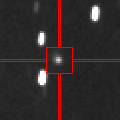
|
Now it is 16.9 mag (Jan. 19, ATLAS Chile). It stays 17 mag for a while. In the Northern Hemisphere, it will be unobservable in April. In the Southern Hemisphere, it stays observable in good condition.
Date(TT) R.A. (2000) Decl. Delta r Elong. m1 Best Time(A, h)
Jan. 20 4 47.39 -38 49.4 7.313 7.626 104 17.1 20:50 ( 0, 16)
Jan. 27 4 46.34 -38 8.2 7.338 7.603 101 17.0 20:22 ( 0, 17)
|
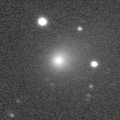
|
It continued brightening even after the perihelion passage, and it brightened up to 13.1 mag in autumn (Sept. 12, Taras Prystavski). Now it is 16.3 mag (Jan. 6, Yukihiro Sugiyama). It will fade out rapidly after this. It will be fainter than 18 mag in February. It locates somewhat low.
Date(TT) R.A. (2000) Decl. Delta r Elong. m1 Best Time(A, h)
Jan. 20 0 17.65 -10 17.5 4.115 3.745 61 17.1 18:43 ( 43, 34)
Jan. 27 0 24.30 -9 6.9 4.246 3.791 56 17.4 18:50 ( 51, 31)
|
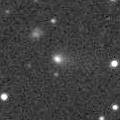
|
Now it is 16.6 mag (Jan. 4, Ken-ichi Kadota). Fading slowly. It will be fainter than 18 mag in March. In the Northern Hemisphere, it stays observable in good condition. In the Southern Hemisphere, it will be getting lower gradually.
Date(TT) R.A. (2000) Decl. Delta r Elong. m1 Best Time(A, h)
Jan. 20 3 19.20 6 23.9 2.811 3.276 109 17.1 19:23 ( 0, 62)
Jan. 27 3 21.63 7 1.0 2.921 3.291 103 17.3 18:58 ( 0, 62)
|
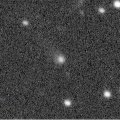
|
Now it is 16.9 mag (Jan. 3, W68 ATLAS Chile). Fading slowly. It will be fainter than 18 mag in April. In the Northern Hemisphere, it will never be observable after this. In the Southern Hemisphere, it stays observable in good condition.
Date(TT) R.A. (2000) Decl. Delta r Elong. m1 Best Time(A, h)
Jan. 20 7 6.95 -72 34.1 3.769 3.838 86 17.1 23:05 ( 0,-18)
Jan. 27 6 32.15 -72 44.9 3.791 3.854 86 17.2 22:03 ( 0,-18)
|
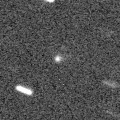
|
Now it is 17.3 mag (Jan. 15, ATLAS-HKO, Haleakala). It stays 17 mag for a while. It will be getting lower gradually after this, and it will be unobservable in May.
Date(TT) R.A. (2000) Decl. Delta r Elong. m1 Best Time(A, h)
Jan. 20 1 35.98 1 29.2 2.461 2.549 83 17.2 18:43 ( 27, 54)
Jan. 27 1 42.05 2 28.7 2.516 2.512 78 17.2 18:50 ( 38, 51)
|

|
It approached to Earth down to 0.29 a.u. in early last February, and it brightened up to 4.5 mag (Feb. 1, Juan Jose Gonzalez). Now it is 19.2 mag (Jan. 12, ATLAS South Africa). Fading slowly. It will be fainter than 18 mag in March. In the Northern Hemisphere, it will never be observable after this. In the Southern Hemisphere, it stays observable in good condition.
Date(TT) R.A. (2000) Decl. Delta r Elong. m1 Best Time(A, h)
Jan. 20 3 10.48 -58 1.5 4.879 4.825 81 17.3 19:13 ( 0, -3)
Jan. 27 3 5.65 -56 50.3 4.992 4.893 78 17.4 18:50 ( 1, -2)
|
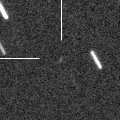
|
Now it is 17.2 mag (Jan. 17, ATLAS Chile). Fading gradually. It will be fainter than 18 mag in March. It locates somewhat low in the Northern Hemisphere. In the Southern Hemisphere, it stays observable in good condition.
Date(TT) R.A. (2000) Decl. Delta r Elong. m1 Best Time(A, h)
Jan. 20 10 29.32 -27 24.8 1.588 2.256 120 17.3 2:36 ( 0, 28)
Jan. 27 10 3.67 -30 45.8 1.567 2.289 126 17.3 1:44 ( 0, 24)
|
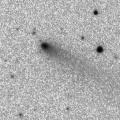
|
Now it is 16.3 mag (Jan. 6, Yukihiro Sugiyama). It stays 18 mag for a while. In the Northern Hemisphere, it will be getting lower gradually. In the Southern Hemisphere, it will be unobservable in March. It is brighter than this ephemeris recently.
Date(TT) R.A. (2000) Decl. Delta r Elong. m1 Best Time(A, h)
Jan. 20 0 27.64 -2 44.4 4.220 3.929 66 17.4 18:43 ( 46, 41)
Jan. 27 0 33.01 -1 56.3 4.331 3.945 60 17.4 18:50 ( 54, 38)
|

|
It is expected to brighten up to 15.5 mag from March to April. Now it is 17.6 mag (Jan. 13, Catalina Sky Survey). Brightening gradually. It locates somewhat low in the Northern Hemisphere. But it will become high in spring. In the Southern Hemisphere, it will be getting higher gradually.
Date(TT) R.A. (2000) Decl. Delta r Elong. m1 Best Time(A, h)
Jan. 20 16 5.24 -13 35.8 1.895 1.597 57 17.7 5:37 (316, 29)
Jan. 27 16 27.14 -14 5.0 1.837 1.578 59 17.4 5:35 (317, 29)
|

|
It brightened up to 14.1 mag in 2022 spring (Mar. 22, 2022, Chris Wyatt). Now it is 17.0 mag (Jan. 7, ATLAS-HKO, Haleakala). It stays 18 mag for a while. In the Northern Hemisphere, it will be getting lower gradually. In the Southern Hemisphere, it will be unobservable in March.
Date(TT) R.A. (2000) Decl. Delta r Elong. m1 Best Time(A, h)
Jan. 20 1 16.12 2 14.1 6.180 6.076 79 17.4 18:43 ( 35, 52)
Jan. 27 1 16.25 2 49.8 6.347 6.124 72 17.4 18:50 ( 47, 48)
|
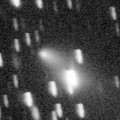
|
It brightened up to 13.6 mag in summer (July 16, Mitsunori Tsumura). Now it is 17.1 mag (Jan. 10, Thomas Lehmann). Fading gradually. It will be fainter than 18 mag in February. In the Northern Hemisphere, it stays observable in good condition. In the Southern Hemisphere, it will never be observable after this.
Date(TT) R.A. (2000) Decl. Delta r Elong. m1 Best Time(A, h)
Jan. 20 0 24.54 63 5.6 2.342 2.656 97 17.4 18:43 (154, 55)
Jan. 27 0 40.95 62 57.0 2.440 2.705 94 17.6 18:50 (152, 54)
|
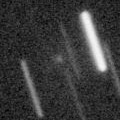
|
It brightened up to 14.7 mag at the discovery in December (Dec. 6, Hidetaka Sato). Now it is 17.3 mag (Jan. 11, Ken-ichi Kadota). Fading rapidly. It will be fainter than 18 mag in February. In the Northern Hemisphere, it stays observable in good condition. In the Southern Hemisphere, it will never be observable after this.
Date(TT) R.A. (2000) Decl. Delta r Elong. m1 Best Time(A, h)
Jan. 20 16 48.51 79 29.2 1.304 1.805 103 17.4 5:37 (191, 42)
Jan. 27 19 20.07 81 51.8 1.439 1.892 100 17.9 5:35 (190, 36)
|

|
Now it is 17.5 mag (Jan. 4, ATLAS-MLO, Mauna Loa). Fading gradually. It will be fainter than 18 mag in February. In the Northern Hemisphere, it stays observable in good condition. In the Southern Hemisphere, it will never be observable after this.
Date(TT) R.A. (2000) Decl. Delta r Elong. m1 Best Time(A, h)
Jan. 20 1 44.22 74 15.7 1.489 2.024 108 17.4 18:43 (175, 50)
Jan. 27 2 35.66 71 59.3 1.510 2.040 107 17.5 18:50 (176, 53)
|
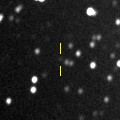
|
Now it is 16.9 mag (Jan. 11, Toshihiko Ikemura, Hirohisa Sato). It stays 17 mag for a while. It stays observable in good condition.
Date(TT) R.A. (2000) Decl. Delta r Elong. m1 Best Time(A, h)
Jan. 20 8 2.29 -9 23.6 3.953 4.832 150 17.5 0:09 ( 0, 46)
Jan. 27 7 58.70 -9 31.0 3.912 4.793 150 17.5 23:34 ( 0, 45)
|

|
Now it is 17.7 mag (Jan. 9, Toshihiko Ikemura, Hirohisa Sato). It stays 18 mag for a while. In the Northern Hemisphere, it will be getting lower gradually. But it will be getting higher again after March. In the Southern Hemisphere, it is not observable now, but it will appear in April.
Date(TT) R.A. (2000) Decl. Delta r Elong. m1 Best Time(A, h)
Jan. 20 22 33.51 38 34.6 4.500 4.238 68 17.5 18:43 (114, 41)
Jan. 27 22 34.46 37 56.9 4.581 4.231 63 17.6 18:50 (115, 35)
|
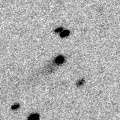
|
Now it is 17.4 mag (Jan. 18, ATLAS-MLO, Mauna Loa). It stays 18 mag for a while. It stays observable in good condition.
Date(TT) R.A. (2000) Decl. Delta r Elong. m1 Best Time(A, h)
Jan. 20 12 26.20 15 36.3 8.877 9.380 118 17.5 4:32 ( 0, 70)
Jan. 27 12 23.60 16 8.2 8.788 9.393 125 17.5 4:02 ( 0, 71)
|

|
New peridic comet which brightened up to 16 mag in 2007. It has not been recovered yet. It was missed in 2013 and 2018. It will approach to Earth down to 0.34 a.u. in winter, and it is expected to brighten up to 16 mag. Fading rapidly. It will be fainter than 18 mag soon. In the Northern Hemisphere, it stays observable in good condition. It stays extremely low in the Southern Hemisphere.
Date(TT) R.A. (2000) Decl. Delta r Elong. m1 Best Time(A, h)
Jan. 20 2 42.85 41 23.6 0.516 1.259 110 17.6 18:50 (180, 83)
Jan. 27 3 29.91 41 6.6 0.615 1.346 112 18.1 19:09 (180, 84)
|

|
Now it is 17.4 mag (Jan. 10, ATLAS Chile). Fading gradually. It will be fainter than 18 mag in March. It stays observable in good condition.
Date(TT) R.A. (2000) Decl. Delta r Elong. m1 Best Time(A, h)
Jan. 20 12 11.41 4 21.3 1.482 2.130 118 17.6 4:17 ( 0, 59)
Jan. 27 12 14.58 3 37.8 1.418 2.133 124 17.6 3:53 ( 0, 59)
|

|
Now it is 17.7 mag (Jan. 11, Ken-ichi Kadota). Brightening slowly. It locates somewhat low in the Northern Hemisphere. In the Southern Hemisphere, it stays observable in good condition.
Date(TT) R.A. (2000) Decl. Delta r Elong. m1 Best Time(A, h)
Jan. 20 15 10.58 -26 7.4 3.452 3.198 66 17.8 5:37 (336, 24)
Jan. 27 15 18.97 -26 43.6 3.356 3.193 72 17.7 5:35 (340, 25)
|
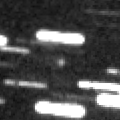
|
Now it is 18.6 mag (Jan. 11, Yasukazu Ikari). It stays 18 mag for a while. It stays observable in good condition.
Date(TT) R.A. (2000) Decl. Delta r Elong. m1 Best Time(A, h)
Jan. 20 6 38.27 9 10.1 6.855 7.766 156 17.7 22:41 ( 0, 64)
Jan. 27 6 32.52 9 12.1 6.907 7.768 149 17.7 22:08 ( 0, 64)
|
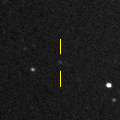
|
Now it is 17.6 mag (Jan. 15, ATLAS-HKO, Haleakala). It stays 18 mag for a while. It stays observable in good condition.
Date(TT) R.A. (2000) Decl. Delta r Elong. m1 Best Time(A, h)
Jan. 20 11 4.62 0 27.6 5.335 6.035 131 17.8 3:11 ( 0, 55)
Jan. 27 11 1.79 1 21.2 5.212 5.998 139 17.8 2:41 ( 0, 56)
|
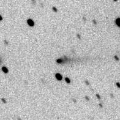
|
Now it is 17.2 mag (Jan. 19, ATLAS-HKO, Haleakala). Fading slowly. It will be fainter than 18 mag in February. It stays observable in good condition.
Date(TT) R.A. (2000) Decl. Delta r Elong. m1 Best Time(A, h)
Jan. 20 8 38.58 -4 15.5 3.161 4.068 154 17.8 0:45 ( 0, 51)
Jan. 27 8 34.47 -3 53.1 3.157 4.083 157 17.8 0:14 ( 0, 51)
|
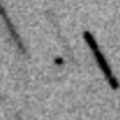
|
Now it is 18.0 mag (Jan. 14, Toshihiko Ikemura, Hirohisa Sato). Brightening gradually. In the Northern Hemisphere, it will be getting lower gradually after this, and it will be unobservable in April. In the Southern Hemisphere, it will be getting lower gradually. It will brighten up to 11 mag in summer. But it is not observable at the high light.
Date(TT) R.A. (2000) Decl. Delta r Elong. m1 Best Time(A, h)
Jan. 20 2 11.18 -8 57.9 3.039 3.168 88 17.9 18:43 ( 10, 46)
Jan. 27 2 12.62 -8 28.7 3.062 3.086 82 17.8 18:50 ( 21, 44)
|
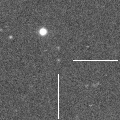
|
Far asteroid moving along a cometary orbit. It brightens up to 18 mag from 2024 to 2025. It stays 18 mag for a while. In the Northern Hemisphere, it stays observable in good condition. It stays extremely low in the Southern Hemisphere.
Date(TT) R.A. (2000) Decl. Delta r Elong. m1 Best Time(A, h)
Jan. 20 8 38.42 50 58.5 7.930 8.786 148 17.8 0:46 (180, 74)
Jan. 27 8 30.81 50 58.4 7.934 8.782 147 17.8 0:11 (180, 74)
|
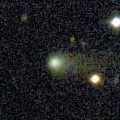
|
It brightened up to 13.9 mag in early 2023 (Jan. 21, Hidenori Nohara). Now it is 19.1 mag (Jan. 11, Toshihiko Ikemura, Hirohisa Sato). It stays 18 mag for a while. In the Northern Hemisphere, it stays observable in good condition. In the Southern Hemisphere, it will be getting higher gradually.
Date(TT) R.A. (2000) Decl. Delta r Elong. m1 Best Time(A, h)
Jan. 20 14 33.42 6 38.6 4.571 4.602 85 17.8 5:37 (330, 58)
Jan. 27 14 37.04 6 52.5 4.511 4.643 91 17.9 5:35 (340, 60)
|
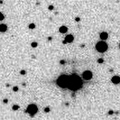
|
Now it is 18.9 mag (Jan. 13, ATLAS-MLO, Mauna Loa). It stays 18 mag for a while. It stays observable in good condition.
Date(TT) R.A. (2000) Decl. Delta r Elong. m1 Best Time(A, h)
Jan. 20 10 12.75 12 36.2 3.366 4.236 148 17.9 2:19 ( 0, 67)
Jan. 27 10 9.59 12 52.8 3.325 4.245 156 17.9 1:49 ( 0, 68)
|
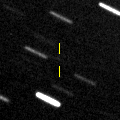
|
Now it is 18.2 mag (Jan. 8, Toshihiko Ikemura, Hirohisa Sato). Fading gradually. It locates somewhat low in the Northern Hemisphere. It stays extremely low in the Southern Hemisphere.
Date(TT) R.A. (2000) Decl. Delta r Elong. m1 Best Time(A, h)
Jan. 20 23 35.92 -7 48.9 2.180 1.762 52 18.5 18:43 ( 55, 29)
Jan. 27 23 52.14 -5 36.1 2.236 1.770 49 18.6 18:50 ( 60, 28)
|
|
![]()
 C/2017 K2 ( PanSTARRS )
C/2017 K2 ( PanSTARRS ) C/2023 A3 ( Tsuchinshan-ATLAS )
C/2023 A3 ( Tsuchinshan-ATLAS ) 29P/Schwassmann-Wachmann 1
29P/Schwassmann-Wachmann 1 C/2019 U5 ( PanSTARRS )
C/2019 U5 ( PanSTARRS ) C/2022 L2 ( ATLAS )
C/2022 L2 ( ATLAS ) 207P/NEAT
207P/NEAT C/2023 H2 ( Lemmon )
C/2023 H2 ( Lemmon ) C/2021 T4 ( Lemmon )
C/2021 T4 ( Lemmon ) C/2021 G2 ( ATLAS )
C/2021 G2 ( ATLAS ) C/2019 L3 ( ATLAS )
C/2019 L3 ( ATLAS ) P/2023 W1 ( NEAT )
P/2023 W1 ( NEAT ) 32P/Comas Sola
32P/Comas Sola 13P/Olbers
13P/Olbers C/2023 P1 ( Nishimura )
C/2023 P1 ( Nishimura ) C/2020 K1 ( PanSTARRS )
C/2020 K1 ( PanSTARRS ) C/2019 T4 ( ATLAS )
C/2019 T4 ( ATLAS ) 226P/Pigott-LINEAR-Kowalski
226P/Pigott-LINEAR-Kowalski C/2022 QE78 ( ATLAS )
C/2022 QE78 ( ATLAS ) C/2014 UN271 ( Bernardinelli-Bernstein )
C/2014 UN271 ( Bernardinelli-Bernstein ) C/2023 C2 ( ATLAS )
C/2023 C2 ( ATLAS ) C/2021 X1 ( Maury-Attard )
C/2021 X1 ( Maury-Attard ) C/2022 S4 ( Lemmon )
C/2022 S4 ( Lemmon ) 471P/2023 KF3
471P/2023 KF3 65P/Gunn
65P/Gunn C/2021 Y1 ( ATLAS )
C/2021 Y1 ( ATLAS ) 150P/LONEOS
150P/LONEOS 227P/Catalina-LINEAR
227P/Catalina-LINEAR C/2023 V4 ( Camarasa-Duszanowicz )
C/2023 V4 ( Camarasa-Duszanowicz ) P/2011 NO1 ( Elenin )
P/2011 NO1 ( Elenin ) C/2022 T1 ( Lemmon )
C/2022 T1 ( Lemmon ) C/2021 S4 ( Tsuchinshan )
C/2021 S4 ( Tsuchinshan ) C/2022 U3 ( Bok )
C/2022 U3 ( Bok ) C/2023 F3 ( ATLAS )
C/2023 F3 ( ATLAS ) C/2019 E3 ( ATLAS )
C/2019 E3 ( ATLAS ) C/2023 K1 ( ATLAS )
C/2023 K1 ( ATLAS ) C/2022 R6 ( PanSTARRS )
C/2022 R6 ( PanSTARRS ) C/2022 JK5 ( PanSTARRS )
C/2022 JK5 ( PanSTARRS ) 170P/Christensen
170P/Christensen C/2022 A3 ( Lemmon-ATLAS )
C/2022 A3 ( Lemmon-ATLAS ) 30P/Reinmuth 1
30P/Reinmuth 1 C/2022 E3 ( ZTF )
C/2022 E3 ( ZTF ) C/2022 V2 ( Lemmon )
C/2022 V2 ( Lemmon ) 117P/Helin-Roman-Alu 1
117P/Helin-Roman-Alu 1 125P/Spacewatch
125P/Spacewatch C/2020 Y2 ( ATLAS )
C/2020 Y2 ( ATLAS ) 126P/IRAS
126P/IRAS C/2023 X1 ( Leonard )
C/2023 X1 ( Leonard ) C/2023 T2 ( Borisov )
C/2023 T2 ( Borisov ) C/2023 T3 ( Fuls )
C/2023 T3 ( Fuls ) C/2022 U1 ( Leonard )
C/2022 U1 ( Leonard ) C/2020 F2 ( ATLAS )
C/2020 F2 ( ATLAS ) P/2007 T2 ( Kowalski )
P/2007 T2 ( Kowalski ) 216P/LINEAR
216P/LINEAR 299P/Catalina-PanSTARRS
299P/Catalina-PanSTARRS C/2021 A9 ( PanSTARRS )
C/2021 A9 ( PanSTARRS ) C/2023 H5 ( Lemmon )
C/2023 H5 ( Lemmon ) 408P/2020 M7 ( Novichonok-Gerke )
408P/2020 M7 ( Novichonok-Gerke ) C/2023 R2 ( PanSTARRS )
C/2023 R2 ( PanSTARRS ) (468861) 2013 LU28
(468861) 2013 LU28 C/2020 S4 ( PanSTARRS )
C/2020 S4 ( PanSTARRS ) 244P/Scotti
244P/Scotti P/2018 P3 ( PanSTARRS )
P/2018 P3 ( PanSTARRS )![]()
































































